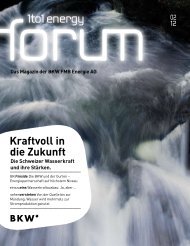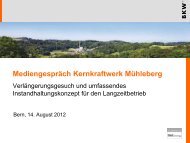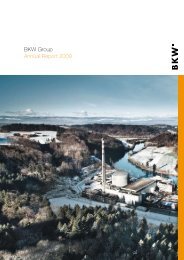BKW FMB Energy Ltd Annual Report 2003
BKW FMB Energy Ltd Annual Report 2003
BKW FMB Energy Ltd Annual Report 2003
Create successful ePaper yourself
Turn your PDF publications into a flip-book with our unique Google optimized e-Paper software.
3 Principles of accounting<br />
and valuation<br />
3.1 Financial assets and liabilities<br />
In accordance with IAS 39, fi nancial assets<br />
and liabilities are valued as follows:<br />
Guaranteed loans, receivables, fi nancial<br />
assets held to maturity and liabilities not<br />
held for trading (in particular, supplier<br />
liabilities) are measured at acquisition<br />
costs (including transaction costs). Premiums<br />
or discounts on these are carried<br />
at amortised cost using the effective<br />
interest method. A value adjustment is<br />
made if there is considered to be a risk of<br />
loss of value. Impairments are charged to<br />
income at nominal or cost price.<br />
Assets and liabilities held in the short term<br />
for trading, as well as all other fi nancial<br />
assets whose value can be reliably measured<br />
are recorded at fair value. If fair values<br />
cannot be determined, such assets and<br />
liabilities are carried at acquisition costs<br />
less value adjustments. Derivatives are<br />
always stated at fair value. Changes in fair<br />
value are recognised in net profi t or loss.<br />
Transactions are recorded on the trade<br />
date. Financial assets are derecognised<br />
when the rights are realised or have expired,<br />
or when the <strong>BKW</strong> Group hands<br />
over control. Financial liabilities are derecognised<br />
only when they are discharged.<br />
3.2 Property, plant and equipment<br />
Property, plant and equipment are recorded<br />
at purchase or manufacturing cost<br />
less accumulated depreciation. Depreciation<br />
is calculated using the straight-line<br />
method and systematically based on the<br />
useful lives of the objects.<br />
Cash values of estimated dismantling and<br />
decommissioning costs are charged to the<br />
balance sheet together with acquisition or<br />
manufacturing costs (IAS 16 and 37, see<br />
also under Provisions). For long-term investment<br />
projects, the borrowing interest<br />
is charged to the balance sheet during the<br />
set-up phase. Land is valued at acquisition<br />
value. Depreciation is recorded only<br />
in the event of a lower market value.<br />
36<br />
Repairs and maintenance with no added<br />
value are charged to the income statement<br />
as incurred. They are carried as<br />
assets only if the costs extend the original<br />
useful life or give rise to other signifi cant<br />
economic benefi ts (cost reduction, increase<br />
in earnings).<br />
The useful life of property, plant<br />
and equipment is estimated as follows:<br />
Land and sites under only if value<br />
construction diminishes<br />
Buildings 50 years<br />
Power plants 40 to 80 years<br />
Transmission and<br />
distribution plants 20 to 40 years<br />
IT systems 10 to 30 years<br />
Operating facilities<br />
and vehicles 3 to 20 years<br />
Depreciation on property, plant and<br />
equipment under licence is calculated up<br />
to the expiry of the licence.<br />
3.3 Non-current fi nancial assets<br />
Non-current fi nancial assets cover participations,<br />
fi nancial loans, fi nancial claims<br />
and securities.<br />
Debentures to associated companies<br />
and third parties as well as long-term<br />
fi nancial claims on fi nancial institutions<br />
are accounted for at acquisition cost less<br />
reductions in value.<br />
Participations and securities which are<br />
recorded under available-for-sale fi nancial<br />
assets and have a market value are<br />
measured at market value. Changes in<br />
value are charged or credited to the fi nancial<br />
result. Other securities are recorded<br />
in the balance sheet at acquisition value<br />
less required value adjustments.<br />
Long-term receivables with respect to<br />
state funds (federal decommissioning<br />
and disposal funds) are valued at the cash<br />
value of anticipated future reimbursements<br />
from the state funds. Future reimbursements<br />
from the funds are estimated<br />
by calculating the provision and the cash<br />
outfl ow to the state funds (see Provisions<br />
and Contingencies).<br />
3.4 Intangible assets<br />
Intangible assets cover rights of use and<br />
goodwill.<br />
Rights of use are contractually agreed<br />
upon non-recurrent amounts to compensate<br />
a contractual partner for the use of its<br />
operating installations as well as licences<br />
for the construction and operation of the<br />
company’s own installations. Rights of<br />
use are written down over the period of<br />
use, or at most the contract period, using<br />
the straight-line method. Goodwill from<br />
the purchase of participations is amortised<br />
on a straight-line basis over the<br />
anticipated life up to 20 years.<br />
3.5 Inventories<br />
Inventories are recorded at the lower of<br />
acquisition/manufacturing cost or net<br />
realisable value. Nuclear fuel produced<br />
specifi cally for <strong>BKW</strong> is valued at acquisition<br />
cost, and wear and tear (burn-off)<br />
is charged to expense items under nuclear<br />
fuel and disposal expenses.<br />
3.6 Accounts receivable / Prepaid<br />
expenses and deferred income<br />
With the exception of fi nancial assets,<br />
accounts receivable and other current<br />
assets are stated at acquisition cost less<br />
operationally necessary adjustments for<br />
losses. Prepaid expenses and deferred<br />
income cover the periodical adjustment<br />
of expenses and income.<br />
3.7 Production contracts<br />
Production contracts are valued according<br />
to the percentage of completion or<br />
POC method. The stage of completion<br />
is determined on the basis of individual<br />
progress reports or cost estimates. The<br />
pro rata income is recorded in the income<br />
statement as revenue. Orders and order<br />
groups whose pro-rata income cannot<br />
be reliably estimated are capitalised. Anticipated<br />
losses are immediately adjusted<br />
in their entirety. Work in progress – after<br />
taking into account customer payments –<br />
is stated under accounts receivable, as net<br />
assets from production contracts.


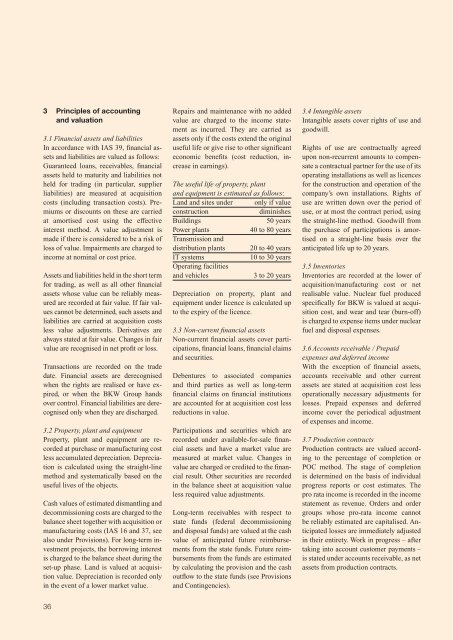
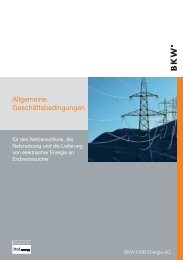

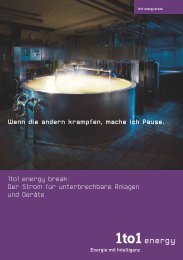
![Geschäftsbericht 2002 [PDF, 0.8 MB] - BKW](https://img.yumpu.com/10617024/1/184x260/geschaftsbericht-2002-pdf-08-mb-bkw.jpg?quality=85)
![Geschäftsbericht 2001 [PDF, 0.9 MB] - BKW](https://img.yumpu.com/10616911/1/184x260/geschaftsbericht-2001-pdf-09-mb-bkw.jpg?quality=85)
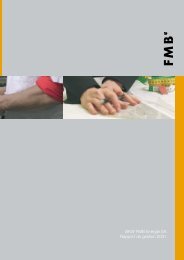

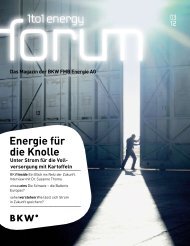
![Referat Streiff 11.07.2006 [PDF] - BKW](https://img.yumpu.com/9314454/1/184x260/referat-streiff-11072006-pdf-bkw.jpg?quality=85)
